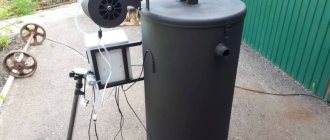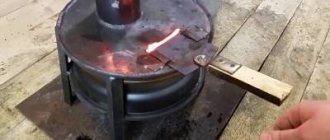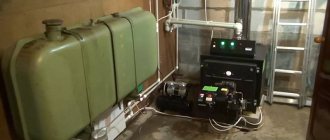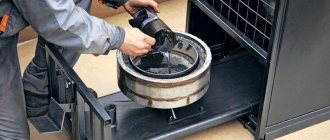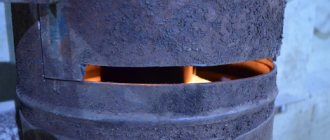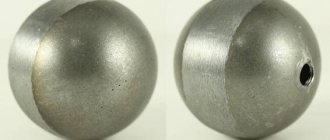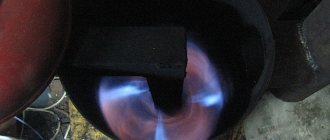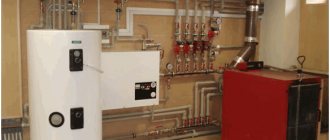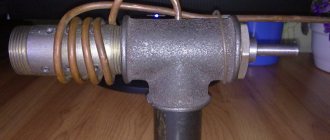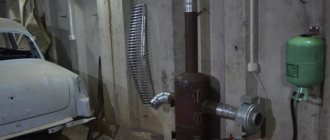The operating costs of waste oil heating boilers are among the lowest, often even lower than the cost of gas. The process of installing heating equipment is also cheap, and boilers operating on exhaust gas are comparable in reliability to their gas or diesel counterparts.
However, they still have not gained wide popularity due to the high initial cost (usually from 100 thousand rubles), the need for constant daily care, and less functional automation and controls (with the exception of extremely expensive models). However, if you understand all the advantages and disadvantages of oil boilers, the choice may well be justified.
Who is this device suitable for?
The average consumption of waste oil when burned in a boiler with a capacity of 20–30 kW/h is approximately 10 liters of fuel per day , that is, heating an insulated private house with an area of 100–150 m2 during one season will require 1–2 m3 of waste oil.
Therefore, this heating method is suitable only for those who have the opportunity to obtain such a volume of fuel for free or at a low price (up to five rubles per liter).
At this price, the costs will be comparable to the costs of purchasing firewood and coal or network gas necessary to heat an insulated house of such area.
If the cost is 5–10 rubles, then the costs will be more than for wood or coal heating, but comparable to heating a house with electricity or fuel oil; a further increase will deprive boilers during development of their main advantage.
Therefore, a boiler running on machine oil is most suitable for owners of enterprises that have many cars on their books.
Installation Tips
Installing a boiler that uses waste oil is practically no different from installing other types of heaters. There is one advantage: thanks to the presence of turbocharging and smokeless combustion of liquid fuel, the chimney does not have to be raised by 6-7 meters. It is enough to remove the chimney head from the wind pressure zone and raise it to a height of 4 m.
Regarding proper installation, we will give the following recommendations:
- The boiler and steel chimneys not protected by insulation are located at a distance of 0.5 m from combustible walls and other elements of a wooden house. The minimum distance from fireproof structures is 100 mm.
- Pass through the outer wall and the entire outer section of the flue with an insulated pipe - a sandwich, otherwise there will be a lot of condensation and soot. The chimney installation technology is described in detail in a separate material.
- Be sure to install a safety group on the heating supply line.
- Organize a good exhaust hood in the furnace to remove odors. Combustion air intake can be provided from the street.
- Equip the supercharger with a speed regulator and the oil line with a valve. This will allow you to control the power of the heat generator manually. Do not confuse the control valve with a regular tap; shut-off valves are installed on pipelines in any case.
- Make a primitive automatic emergency stop - install a thermostat on the supply, turn off the fan and the oil pump in case of overheating of the coolant.
If the waste is supplied by gravity, then for safety reasons it is advisable to install an electric shut-off valve on the fuel line. One subtlety: after an emergency shutdown, the boiler will not start on its own; you will have to light the oil manually or set up automatic ignition.
It is very advisable to insure the operation of the boiler in case of a power outage. A car fan, designed for a voltage of 12 volts, can be powered from a conventional battery, the rest of the equipment - pumps, thermostats - through an uninterruptible power supply unit.
The easiest way to supply used oil to the combustion chamber of the boiler is by gravity - from a container suspended from the wall. But such a system must be constantly monitored, plus as it is emptied, the interval between drops increases and the combustion intensity decreases.
Device
Such a boiler is identical in design to all other liquid fuel heating devices and consists of :
- combustion chambers (furnaces);
- nozzles;
- water jacket;
- heat exchanger;
- housings;
- fuel equipment.
The firebox is surrounded on all sides by a water jacket, which takes away the heat generated by the fuel and spends it on heating the coolant (water or antifreeze).
At the bottom of the firebox there is a nozzle that sprays liquid fuel and mixes it with air, thus forming an air-fuel mixture. There are also models without a nozzle ; in them, this role is played by various burners that heat and burn waste oil.
After combustion of the mixture, hot flue gases are formed, which pass through the heat exchanger, heating the water for hot water supply.
In many models of such boilers, the heat exchanger, or water circuit, operates in parallel with the water jacket, increasing the efficiency of the heating device, but when operating at low power, this reduces the temperature of the flue gases and leads to the appearance of condensation in the chimney.
The fuel equipment supplies exhaust gas to the nozzle, and after the water jacket warms up to a certain level, it stops supplying, thus ensuring temperature stability in the house .
Often in boilers, fuel equipment and a nozzle are combined into one device. The housing insulates the water jacket, so accidental touching the boiler does not cause burns.
Arrangement of doors
Making a chimney I made a smoke exhaust structure from a 10-centimeter pipe.
Nothing supernatural - I simply welded the pipe to the hole in the center of the top of the body. The chimney led to the street through the wall to the roof. A piece of metal sheet was attached to the wall for fire protection. It is better to pass the pipe itself through the wall in a special fireproof glass.
Here you can see how the pipe goes through the wall
The stove is almost ready. The finishing touches remain. I cut an opening in the door of the lower chamber through which air can freely flow to the pan and the stove burner.
I riveted the thrust plates and assembled a simple lock for the top door. During the heating process, the stove body “leads”. To ensure that the combustion chamber remains airtight, the top door must close as securely as possible. That's why I made the castle.
Simple castle
I screwed several pieces of metal corner to the wall.
I installed the stove on the screwed corner. This is both convenient (if necessary, it will be much easier to carry out an inspection) and functional (heat loss into the ground is reduced).
Installed the stove
Range and prices of boilers for private homes
In this section you will find a description of the most popular boilers that use waste oil as fuel.
Most of them can work without any modifications on other types of mining, for example, diesel fuel, but to convert to fuel oil, another burner is needed. They can also be converted to gas, but this will also require an appropriate burner.
EcoBoil-18/30
This 15 kW/h heating device uses any liquid fuel, including waste fuel, as fuel. It is suitable for well-insulated houses with an area of 150–200 m2, as well as for poorly insulated houses with an area of 50–100 m2.
The device is supplied
with two types of burners:
- automatic;
- semi-automatic.
The automatic burner is equipped with a nozzle and also ignites the fuel independently, but requires a constant connection to a 220 V power supply.
Automation regulates the temperature by turning the fuel supply on and off, that is, it works in start/stop mode. The fuel combustion is controlled by a photosensor that transmits information to the control unit.
After several unsuccessful attempts to ignite the fuel, the injector is turned off, and the memory of the control device generates error information. It will be possible to start the boiler only after troubleshooting and clearing the error. The combustion chamber equipped with an automatic burner must be cleaned once a month.
Before entering the nozzle, the waste passes through a triple filter and a heating section. This filtration reduces the likelihood of contamination of the nozzle holes, which is why it lasts longer before repair or replacement.
Thanks to heating, the viscosity of the fuel is reduced, which leads to better atomization and more efficient combustion, which means an increase in the efficiency of the boiler, while fuel consumption is 0.5–2 l/h .
One of the disadvantages of this burner is the high electricity consumption of 0.5–1.5 kW/h, most of which is consumed by the boost fan, which creates the air pressure necessary to move the fuel to the nozzle.
The semi-automatic burner is equipped with a drip fuel supply system, which is then thermally decomposed into pyrolysis gases and non-combustible slag , after which the pyrolysis gases ignite and release thermal energy.
To regulate the heat generated, the fuel supply is reduced or increased (consumption 0.5–2 l/h); complete stop of the burner is provided only during cleaning.
The electricity consumption of this burner is noticeably lower (100–250 W), and it can operate either from a 220 V network or from a 12 V battery.
One of the significant advantages of semi-automatic burners is the ability to work even on dirty and thick fuel, and the flame is controlled using an analogue temperature sensor , which turns off the burner when the temperature drops below the permissible level.
The volume of the water jacket is 18 liters, this allows the device to operate efficiently even in low power mode, however, effective operation at maximum power is only possible in forced heating systems equipped with a water pump.
The cost of a boiler with an automatic burner is 95 thousand rubles, with a semi-automatic burner 50 thousand rubles.
TeploTerm GMB 10-15 kW
This heating device with a maximum power of 15 kW/h is equipped with a semi-automatic burner with manual ignition and two operating modes (minimum and maximum power).
Thanks to built-in fuel combustion and coolant temperature sensors, the control unit monitors the operation of the boiler and regulates the temperature, including the required operating mode .
The volume of the water jacket is 19 liters, thanks to which the boiler quickly heats the coolant and warms up the rooms. The maximum power consumption, regardless of operating mode, does not exceed 200 W. Fuel consumption depends on the operating mode and is 0.9–1.7 l/h, and the cost of the device is 75 thousand rubles.
Triumph - 15 kW
The Triumph device is a rather controversial unit that operates on waste, suitable for heating well-insulated houses with an area of 50–150 m2. We call it controversial because at a low price (40 thousand rubles), it collected many negative reviews on the Internet, and the owners’ complaints related to both its design and operation.
There is no normal description of this heating device on the manufacturer’s website , and the operating instructions cannot be found on the Internet.
The boiler is equipped with a burner with manual ignition, and to regulate power, the control unit changes the volume of fuel supplied per unit of time.
The temperature sensor monitors fuel combustion in the chamber and gives a signal when the temperature drops below the permissible level, after which the control unit stops supplying fuel.
The volume of the water jacket is 20 liters, so the device quickly heats the water in the heating system. The fuel consumption of this boiler is 1–2 l/h.
Rating of popular models
The long service life of a boiler and its efficiency largely depend on its quality. Today, several heating devices operating on liquid fuel are recognized as the best models.
Russian-made waste oil boilers:
- "GEKKON 50";
- "EcoBoil-18/30";
- "KChM-5-K-38";
- "Teplamos NT - 100".
European models:
- "DanVex B30";
- "EnergyLogic EL-375B";
- "Euronord K200";
- "Ecoheat 60S".
Waste oil boiler DanVex B30
All heating units operate on various types of waste oil and its mixtures. Their feature is ease of use and high performance coefficient.
Large boilers
The only difference between large high-power boilers is that they are made from thicker steel, but the principle of operation is the same as that of devices designed for heating houses.
The lower power limit of these devices is 30 kW, but the upper limit is not limited, so there are heating devices that produce 100 kW or more.
TEPLOCASTO TKS-KA 40 kW
The main difference of this heating device is a three-pass heat exchanger with increased efficiency. Thanks to the third row of smoke pipes located inside the water jacket, the device absorbs more heat.
This increases its efficiency in high power mode, but when operating at low power the risk of condensation in the chimney increases sharply.
This happens due to the lower temperature of the flue gases reaching the chimney, because the additional part of the heat was taken away by the water jacket around the third row of smoke pipes.
However, automatic ignition and operation in start/stop mode compensate for this shortcoming, turning the TEPLOKASTO TKS-KA three-pass boiler into one of the best heating devices of its power (40 kW). Fuel consumption is 1.2–3 l/h, electricity consumption is 0.5–2 kW/h.
The control unit has an automatic start program, according to which the fuel is first warmed up in a bath intended for this purpose, then the air supply is turned on, which entrains oil particles and mixes with them.
When this mixture enters the combustion chamber, it is ignited, constantly monitoring the temperature. If 9 attempts to ignite the mixture are unsuccessful, the device turns off and it can be switched to operating mode only after the causes have been eliminated and the error has been reset.
If during operation of the burner the torch goes out for any reason, then the automatic system is immediately activated , shutting off the fuel supply. Cleaning holes are provided on all sides of the heater to facilitate its maintenance. The volume of the boiler water jacket is 48 liters, the cost is 121 thousand rubles.
POLARUS P12M
This boiler with electric ignition operates in start/stop mode, but a power change mode is also available, the range of which is 10–80 kW.
The device is equipped with a drip nozzle and a low-power air blower (200 W), thanks to which energy consumption does not exceed this value.
Fuel consumption is 1–6 l/h depending on the operating mode. The volume of the water jacket is 35 liters, and the cost of the boiler is 140 thousand rubles.
ZILIM 40
This heating device is equipped with a 40 kW nozzle and is capable of generating thermal energy in the range of 10–40 kW, and the temperature of the exhaust gases, even at minimum mode , is high enough so that condensation does not form in the pipe.
This slightly increases fuel consumption compared to three-pass boilers (3–5%), but extends the service life of the chimney by 1.2–1.5 times with frequent operation in minimum power mode. Fuel consumption 1–4 l/h, electricity consumption 300–1200 W.
Thanks to automatic ignition, the boiler can operate not only at minimum power, but also in start/stop mode, which significantly saves fuel.
If the torch goes out for any reason or ignition fails, the automation activates the ignition device several times , and if there is no positive result, it stops the fuel supply and generates an error signal.
The standard nozzle operates in two power modes (10 and 40 kW), but you can choose a modification with a different burner. The volume of the water jacket is 50 liters, the cost of the boiler with a standard burner is 88 thousand rubles.
Important aspects of keeping your garage warm
Providing a traditional heating system in a garage is not easy, and it is also quite expensive, but maintaining optimal air temperature in such a building is still necessary. After all, it is even better to store transport at a temperature of at least +5 degrees, but some work needs to be done at a temperature of at least +18.
For the most part, car owners, as well as motorcyclists, prefer to use small, economical stoves to heat their garages, which are highly efficient and can warm up the room well.
It is also important that the stove not only saves the family budget, but is also safe and provides quick heating of the garage. It would be good if various wastes could also serve as fuel – for example, waste oil or wood waste. This will also make the furnace a less unprofitable structure.
This will also make the furnace a less unprofitable structure.
Heat loss in a garage is always high - it is rare that a building of this type is properly insulated with good thermal insulation materials
It is also important to understand that heating a small room often requires much more thermal energy than warming a house. To heat a two-story house, you will need a device with a power of about 10 kW, but a design with a capacity of 2.5 kW can heat a standard-sized garage. If you want to ensure that the temperature in the garage is always about 16 degrees, then you need to install a 2 kW unit
Sometimes, in order to save heat, motorists try to heat not the entire garage, but only the place where they directly work
If you want to ensure that the temperature in the garage is always about 16 degrees, then you need to install a 2 kW unit. Sometimes, in order to save heat, motorists try to heat not the entire garage, but only the place where they directly work.
A garage oven is an important piece of equipment that will create optimal conditions even in the cold season
Where can I get oil?
The main suppliers of boiler oil are:
- motor transport enterprises;
- organizations owning railway, river or marine equipment;
- agricultural enterprises;
- car services;
- enterprises and organizations servicing hydraulic equipment;
- any organization that has a lot of cars on its balance sheet.
Any car needs to change the engine oil at least once a year; in addition, from time to time you have to change the lubricant in other equipment.
Disposal of waste petroleum products is legally very expensive , so suppliers of such material sell and often give it away for free in order to relieve themselves of the costs of storage and disposal.
How to make a stove
A homemade exhaust furnace for a garage is made in the following sequence:
Assembly of the lower chamber. In such a furnace, the primary combustion chamber and the fuel tank are combined. This is a round device, closed with a lid, in which holes are drilled for pouring oil and for installing a pipe - the second chamber of the furnace.
Parts for making a furnace for mining
The parts for the lower tank are cut according to the dimensions shown in the photo, the edges are cleaned with a grinder and welded. It is better to make the walls from a piece of pipe.
A bottom made of sheet metal is welded to them, and legs are welded from the corners. A cover with holes is cut out: one hundred millimeters in diameter in the center and 60 millimeters closer to any edge.
Tip: The lid should be removable, which will make it easier to clean the device and transport the oven.
- In a piece of pipe with a diameter of one hundred millimeters and a length of approximately 360 millimeters, holes are drilled for air intake with a diameter equal to one tenth of the diameter of the pipe. The holes must be spaced evenly across the diameter and height of the device.
- The pipe is welded to the lid of the lower tank. In this case, you need to control its perpendicularity of installation. An air damper is placed on the cover; it can be fixed with a rivet or with bolts. The diameter of the hole for mounting the damper is 60 millimeters. Oil is poured into the same hole and the stove is lit.
- The upper tank is assembled similarly to the lower one. For the body, a pipe with a diameter of 355 millimeters is taken. In the plate that will serve as the bottom, a hole with a diameter of one hundred millimeters is made, offset to the edge of the bottom. A small part of a pipe with a diameter of 110 millimeters is welded to it, which will be placed on the perforated chamber where the gases are burned.
- The lid of the upper tank is exposed to high temperatures, so it must be made of metal with a thickness of at least 6 millimeters. There is a hole in it for installing a chimney; it is located on the side opposite the hole at the bottom of the chamber. Between the chimney and the chamber wall, a cut-off device is welded to the top cover, which is a partition made of thick metal. The cutter should be located closer to the smoke exit hole.
- A chimney pipe is welded to the top cover, which is then connected to the chimney. To increase the rigidity of the structure, a spacer is welded between the chambers from a corner or a small diameter pipe.
- The stove can be painted with metal paint that can withstand high temperatures.
Pros and cons of heating by working off
Here are the pros and cons of using waste water heating:
pros:
- minimal fuel costs;
- the ability to convert the boiler to other types of liquid fuel or gas by replacing the nozzle;
- the exhaust burner can be inserted into any air or water heating boiler, originally designed to operate on liquid or gaseous fuel;
- with proper burner settings, waste oil products burn with minimal release of harmful substances;
- the ability to get rid of accumulated waste without expensive disposal.
Minuses:
- the combustion chamber must be frequently cleaned of soot;
- fuel must be stored next to the boiler;
- before burning, the waste must be heated to a temperature of 60–100 degrees;
- When fuel burns, a lot of slag is formed;
- any violation of the correct adjustment of the burner increases the toxicity of the smoke;
- any violation of the draft or nozzle settings leads to the appearance of a strong unpleasant odor and the room is filled with toxic smoke;
- even in devices with a working burner, there is a high probability of fuel spillage, which can lead to a fire;
- If water or brake fluid gets into the exhaust, the injectors often become clogged, which is why you have to clean them.
Safety regulations
When using used heating oil, it is recommended to follow the following safety rules:
- the source should not be placed next to walls lined with flammable materials;
- It is prohibited to use flammable means to ignite oil, as this will lead to ignition and, as a result, a fire;
- the unit is not placed on a floor covered with linoleum, carpet or other covering;
- the stove cannot be extinguished, therefore, before using it, the operating time and the amount of fuel are accurately calculated;
- It is impossible for the oil to contain water, antifreeze or any other liquid.
Used oil is the cheapest type of fuel. This explains the increased demand for this product.
About useful modifications of an iron stove
There are several recommendations on how to make the above design even better. The first step is to strengthen the junction of the chimney pipe to the top slab, since this is the place that burns out most often. The reason is not only the high temperature, but also the load exerted on the weld by the chimney pipe. Typically, garage owners do not bother with separate mounting of the chimney and its entire weight rests on the top panel of the stove.
A wood-burning stove with 2 smoke circuits cannot boast of the size of the firebox, and therefore the duration of combustion. On the other hand, homemade long-burning stoves like “Bubafonya” are not the best option for a garage. They require a chimney at least 4 m high with good draft, which is not always feasible.
The heat transfer of a wood-burning stove can be improved if several vertical ribs are welded to the side walls, as shown in the photo below. A 4 mm thick strip or the same corner is used, thereby increasing the heat exchange area and increasing the efficiency of the heater.
The photo shows a cast iron stove with convection fins and a hob. A similar structure can be welded from steel
